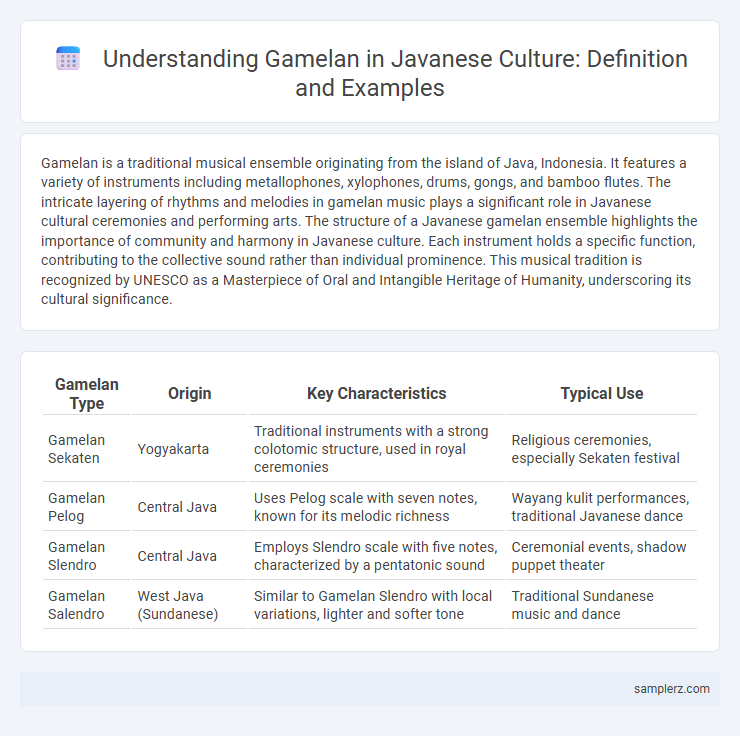Gamelan is a traditional musical ensemble originating from the island of Java, Indonesia. It features a variety of instruments including metallophones, xylophones, drums, gongs, and bamboo flutes. The intricate layering of rhythms and melodies in gamelan music plays a significant role in Javanese cultural ceremonies and performing arts. The structure of a Javanese gamelan ensemble highlights the importance of community and harmony in Javanese culture. Each instrument holds a specific function, contributing to the collective sound rather than individual prominence. This musical tradition is recognized by UNESCO as a Masterpiece of Oral and Intangible Heritage of Humanity, underscoring its cultural significance.
Table of Comparison
| Gamelan Type | Origin | Key Characteristics | Typical Use |
|---|---|---|---|
| Gamelan Sekaten | Yogyakarta | Traditional instruments with a strong colotomic structure, used in royal ceremonies | Religious ceremonies, especially Sekaten festival |
| Gamelan Pelog | Central Java | Uses Pelog scale with seven notes, known for its melodic richness | Wayang kulit performances, traditional Javanese dance |
| Gamelan Slendro | Central Java | Employs Slendro scale with five notes, characterized by a pentatonic sound | Ceremonial events, shadow puppet theater |
| Gamelan Salendro | West Java (Sundanese) | Similar to Gamelan Slendro with local variations, lighter and softer tone | Traditional Sundanese music and dance |
Origins and Historical Development of Javanese Gamelan
Javanese gamelan, originating from the island of Java in Indonesia, traces its roots back to the 8th century during the Medang Kingdom era, evolving through royal courts and religious ceremonies. The ensemble's development was influenced by Hindu-Buddhist culture, reflected in its intricate metallophones, gongs, and drums designed to accompany wayang kulit shadow puppet performances and sacred rituals. Over centuries, Javanese gamelan music became a symbol of spiritual harmony and artistic refinement, deeply embedded in Javanese cultural identity and traditional ceremonies.
Key Characteristics of Javanese Gamelan Music
Javanese gamelan music is characterized by its layered textures and cyclical rhythms created by metallophones, gongs, and drums, producing a serene and meditative sound. The use of pelog and slendro scales defines its unique tonal structure, with each instrument contributing to the rich, interlocking patterns essential in Javanese performances. Dynamic shifts, subtle ornamentation, and a strong emphasis on balance and harmony highlight the spiritual and cultural significance inherent in this traditional ensemble.
Traditional Instruments in Javanese Gamelan
Javanese gamelan features a rich ensemble of traditional instruments, including the metallophones such as the saron and gender, which produce layered melodic patterns essential to the gamelan's distinctive sound. The gong ageng and kempul gongs mark structural phrasing, while the kendang drum guides tempo and dynamics, anchoring the ensemble's rhythm. These instruments collectively create a complex, interlocking texture that embodies Javanese cultural values and spiritual significance.
Regional Variations in Javanese Gamelan Styles
Javanese gamelan exhibits distinct regional variations, notably between Surakarta (Solo) and Yogyakarta styles, each characterized by unique tuning systems and ensemble compositions. Surakarta gamelan emphasizes intricate, lively rhythms with a lighter, more vibrant sound, while Yogyakarta ensembles produce a darker, more meditative tone through slower tempos and denser textures. Both styles reflect local cultural influences and historical developments, enriching the diversity of Javanese gamelan traditions.
Rituals and Ceremonial Functions of Gamelan
Gamelan in Java plays a vital role in rituals and ceremonial functions, often accompanying traditional weddings, religious ceremonies, and royal events to invoke spiritual harmony and communal unity. The ensemble's intricate rhythms and melodic patterns synchronize with dances and chants, marking transitions and symbolizing offerings to ancestral spirits and deities. Its presence reinforces cultural identity and sustains centuries-old traditions central to Javanese social and religious life.
Influential Composers and Maestro of Javanese Gamelan
Influential composers such as Ki Nartosabdho and Raden Mas Sujoko have shaped the evolution of Javanese gamelan with their innovative compositions blending traditional techniques and modern expressions. Maestro Ki Suryono, renowned for his virtuosic command and teaching, has preserved and propagated the intricate rhythms and melodies distinctive to Central Javanese gamelan. These figures exemplify the essential role of individual artistry in sustaining and enriching the cultural heritage of Javanese gamelan music.
Gamelan Ensembles: Structures and Roles
Gamelan ensembles in Java consist of metallophones, xylophones, drums, gongs, and bamboo flutes, each instrument playing a specific role within the intricate musical structure. The kendang drum leads the ensemble by setting tempo and signaling transitions, while the bonang and saron provide melodic patterns that interlock to create polyphonic textures. This hierarchical arrangement ensures a balanced interplay between rhythmic precision and melodic complexity, reflecting deep cultural significance in Javanese ceremonies and performances.
Notable Javanese Gamelan Performances and Festivals
Notable Javanese gamelan performances such as the Sekaten Festival in Yogyakarta showcase the intricate interplay of metallophones, drums, and gongs that define this traditional ensemble. The Surakarta Sunanate hosts the annual Grebeg event, featuring gamelan ensembles performing sacred compositions to honor Javanese heritage. These festivals preserve the rich cultural significance of gamelan music while attracting scholars and tourists interested in Javanese performing arts.
Gamelan in Modern Java: Innovations and Continuity
Gamelan in Modern Java integrates traditional instruments like metallophones and kendang drums with contemporary musical forms, reflecting both innovation and cultural continuity. Musicians incorporate electronic amplification and fusion genres, preserving the ensemble's distinct rhythmic patterns while appealing to younger audiences. This dynamic evolution ensures gamelan remains a vital cultural expression in Indonesia's rapidly changing society.
Global Influence of Javanese Gamelan Culture
Javanese gamelan, characterized by its intricate metallophone ensembles and cyclical musical structures, has significantly influenced global music and performing arts. Worldwide, composers and ethnomusicologists study and incorporate gamelan techniques, fostering cross-cultural collaborations and contemporary adaptations. UNESCO recognition highlights gamelan's role in promoting cultural exchange and preserving intangible heritage.

example of gamelan in Java Infographic
 samplerz.com
samplerz.com